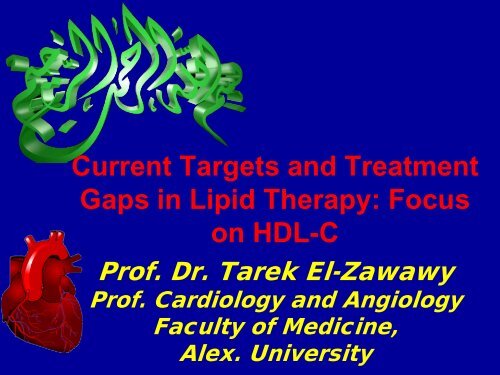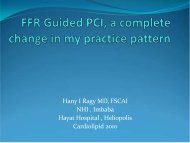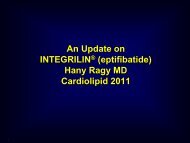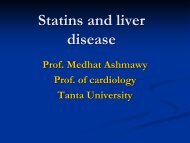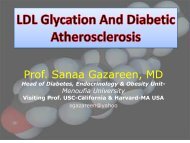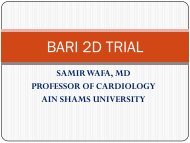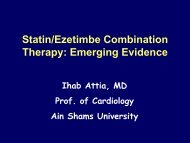Non-HDL-C
Non-HDL-C
Non-HDL-C
You also want an ePaper? Increase the reach of your titles
YUMPU automatically turns print PDFs into web optimized ePapers that Google loves.
Current Targets and Treatment<br />
Gaps in Lipid Therapy: Focus<br />
on <strong>HDL</strong>-C<br />
Prof. Dr. Tarek El-Zawawy<br />
Prof. Cardiology and Angiology<br />
Faculty of Medicine,<br />
Alex. University
Log-linear Relationship Between LDL-C Levels and<br />
Relative Risk for CHD<br />
3.7<br />
Relative<br />
Risk<br />
for<br />
Coronary<br />
Heart<br />
Disease<br />
(Log Scale)<br />
2.9<br />
2.2<br />
1.7<br />
1.3<br />
1.0<br />
40 70 100 130 160 190<br />
LDL-Cholesterol, mg/dL<br />
• This relationship is consistent with a large body of epidemiological data and with data<br />
available from<br />
clinical trials of LDL-lowering therapy<br />
• These data suggest that for every 30-mg/dL change in LDL-C, the relative risk for CHD is<br />
changed in proportion by about 30%. The relative risk is set at 1.0 for LDL-C 40 mg/dL.<br />
Grundy S, et al. Circulation. 2004;110:227-239
Fasting and <strong>Non</strong>fasting TG:<br />
Equally Predictive of CHD Risk*<br />
Fasting<br />
<strong>Non</strong>fasting<br />
Cumulative Probability of Death<br />
20<br />
15<br />
10<br />
5<br />
0<br />
HR † : 1.41<br />
(1.12-1.79)<br />
P = 0.004<br />
TG ≥200 mg/dL<br />
TG
<strong>Non</strong>–<strong>HDL</strong>-C Is Superior to LDL-C<br />
in Predicting CHD Risk<br />
• Within non–<strong>HDL</strong>-C levels, no<br />
association was found between<br />
LDL-C and the risk for CHD<br />
2.5<br />
• In contrast, a strong positive and<br />
graded association between non–<br />
<strong>HDL</strong>-C and risk for CHD occurred<br />
within every level of LDL-C<br />
• <strong>Non</strong>–<strong>HDL</strong>-C is a stronger<br />
predictor of CHD risk than LDL-C<br />
Relative CHD Risk<br />
2<br />
1.5<br />
1<br />
0.5<br />
0<br />
Role of Low <strong>HDL</strong>-C<br />
in Residual<br />
Cardiovascular Risk
Low <strong>HDL</strong>-C and<br />
Cardiovascular Risk<br />
An Independent Frequent Risk Factor<br />
4.0<br />
3.0<br />
4.0<br />
Controls Cases<br />
Risk Factor (N=601) (N=321)<br />
Cigarette smoking<br />
29% 67%*<br />
<strong>HDL</strong>-C 150/90 mmHg)<br />
21% 41%*<br />
LDL-C ≥160 mg/dL 26% 26%*<br />
Diabetes mellitus 1% 12%*<br />
1.0<br />
1.0<br />
0<br />
0.65 1.17 1.68<br />
<strong>HDL</strong>-C (mmol/L)<br />
Kannel WB. AJC 1983; 52: Framingham Study;<br />
Genest JJ et al. Am J Cardiol 1991; 67:1185–1189
Association Between LDL-C, <strong>Non</strong>-<strong>HDL</strong>-C, TGs,<br />
<strong>HDL</strong>-C and CHD Risk<br />
Lipid Level<br />
LDL-C 1 Each 1%<br />
increase in LDL-C<br />
CHD Risk<br />
1% increase in<br />
the risk of CHD in women and<br />
men<br />
<strong>Non</strong>-<strong>HDL</strong>-C 2 Each 1%<br />
increase in <strong>Non</strong>-<strong>HDL</strong>-<br />
C<br />
1% increase in<br />
the risk of CHD in women and<br />
men<br />
TG 3<br />
Each 1 mmol/L<br />
(89 mg/dL)<br />
increase in TG<br />
37% increase in<br />
the risk of CVD in women and<br />
14% increased risk in men<br />
<strong>HDL</strong>-C 4<br />
Each 1 mg/dL<br />
increase in <strong>HDL</strong>-C<br />
2% decrease in CVD death in<br />
men and 3% decrease in CVD<br />
death in women<br />
1 Grundy S, et al. Circulation. 2004;110:227-239.<br />
2 Liu J, et al. Am J Cardiol. 2006;98:1363-1368.<br />
3 Hokanson JE, et al. J Cardiovasc Risk. 1996;3:213-219.<br />
4 Gordon DJ, et al. Circulation. 1989;79:8-15.
Does the <strong>HDL</strong> level matter if<br />
the LDL-C is reduced by<br />
statins and is very low
CHD risk predicted by <strong>HDL</strong> and LDL in the<br />
Framingham Heart Study<br />
CAD Relative Risk<br />
4<br />
3<br />
2<br />
1<br />
0<br />
100 160 220<br />
85<br />
65<br />
45<br />
25<br />
LDL-C (mg/dL)<br />
AJC 2001; 88(suppl): 9N-13N
TNT: Events in <strong>HDL</strong>-C and<br />
LDL-C Quintiles<br />
16<br />
14<br />
5-year K-M incidence<br />
of MCVE (%)<br />
12<br />
10<br />
8<br />
6<br />
4<br />
2<br />
0<br />
1<br />
(
New CV events in MI patients with<br />
normal cholesterol levels<br />
80<br />
75%<br />
New CV events<br />
(% Patients)<br />
60<br />
40<br />
20<br />
45%<br />
0<br />
<strong>HDL</strong> < 35<br />
mg/dl<br />
<strong>HDL</strong> > 35 mg/dl<br />
AJC 2001; 88(suppl): 9N-13N
Results from the statin trials have established<br />
that interventions leading to lower LDL levels<br />
produced a significant reduction in<br />
CHD.However, the extent of this reduction is<br />
incomple.<br />
The decrease in the rate of coronary events<br />
was only 30% to 35%. This implies that a<br />
greater improvement could be achieved<br />
through further interventional measures,<br />
including therapy that modifies lipids other<br />
than LDL”<br />
Poulter NR, Dept of Clinical Pharmacology, Imperial School of Medicine, London<br />
Am J Cardiol 2001;88(suppl):1N-2N
Percentage of patients reaching ADA lipid<br />
targets<br />
Atorvastatin 20 mg Fenofibrate 200 mg Atorvastatin 20 mg + Fenofibrate 200 mg<br />
% of patients reaching ADA goals<br />
120<br />
100<br />
80<br />
60<br />
40<br />
20<br />
0<br />
80<br />
97.5<br />
92.5<br />
100<br />
75<br />
30<br />
17.5<br />
5<br />
LDL TG <strong>HDL</strong><br />
60<br />
Diabetes Care
Percent probability for MI within the next 10 years<br />
as estimated with the PROCAM CAD calculator<br />
25<br />
21.6<br />
20<br />
15<br />
10<br />
7.5<br />
10.9<br />
5<br />
4.2<br />
0<br />
Baseline Atorvastatin 20 mg Fenofibrate 200 mg Atorvastatin 20 mg +<br />
Fenofibrate 200 mg<br />
Diabetes Care 2002;25:1198-1202
IS THERE AN ASYMPTOTIC<br />
LIMIT FOR LDL AT WHICH<br />
CARDIOVASCULAR EVENT<br />
RATES APPROXIMATE<br />
ZERO
The LDL level at which cardiovascular event<br />
rate may approach ZERO is estimated to be<br />
60mg/dl for primary prevention and<br />
30 mg/dl for secondary prevention<br />
1. McKenney. Am J Ther. 2004;11:54-59; 2. Jones et al for the STELLAR Study Group. Am J Cardiol.<br />
2003;92:152-160; 3. Olsson et al. Am Heart J. 2002;144:1044-1051; 4. Expert Panel on Detection,<br />
Evaluation, and Treatment of High Blood Cholesterol in Adults. JAMA. 2001;285:2486-2497.
CAD risk can be reduced to a maximum of<br />
approximately 35% with current statin and/or fibric<br />
acid derivates<br />
Leaving 65% risk reduction to be gained, <strong>HDL</strong>-C<br />
increasing strategies are becoming increasingly<br />
important 1 1<br />
Duffy & Rader Circulation 2006; 113
Time to move beyond LDL
Should both <strong>HDL</strong>-C and LDL-<br />
C be targets for lipid therapy
<strong>HDL</strong>-C Increase and LDL-C Decrease<br />
Additive<br />
% Absolute change in LDL+<strong>HDL</strong><br />
% CV event RRR<br />
0<br />
10<br />
20<br />
30<br />
40<br />
50<br />
60<br />
70<br />
0 10 20 30 40 50 60 70 80<br />
VA HIT<br />
DAIS<br />
BIP<br />
LIPID<br />
HHS<br />
CDP<br />
WOSCOPS<br />
ASCOT<br />
ALLHAT<br />
PROSPER<br />
CARE, HPS<br />
AFCAPS/<br />
TexCAPS<br />
4S<br />
FATS F/U<br />
80<br />
90<br />
HATS<br />
FATS<br />
100<br />
LDL-C lowering<br />
LDL-C lowering<br />
+ <strong>HDL</strong>-C increase<br />
Brown, 2004
Should <strong>HDL</strong> Raising Be a<br />
Target for Lipid Therapy"
Meta-analysis of 4 large<br />
prospective studies<br />
For every 1 mg/dl<br />
increase in <strong>HDL</strong>,<br />
the incidence of<br />
coronary events<br />
decreases by<br />
2% in men and<br />
3% in women.<br />
Am J Cardiol 2001;88(suppl):9N-1
Recommendations for<br />
management of dyslipidemia
Modified ATP III LDL-C Guidelines<br />
Low<br />
(20%)<br />
Very High<br />
(ACS)<br />
NCEP ATPIII, AHA, and ADA:<br />
Recommended Lipid Goals<br />
Parameter ATP III 1 AHA Women 2 (for adults<br />
ADA Position 3<br />
with diabetes)<br />
LDL-C<br />
- Very high risk<br />
NCEP ATP III Guidelines<br />
For all patients, including patients with high TG, or Low<br />
<strong>HDL</strong>), the primary target of therapy is LDL-C.<br />
Statin is the first line therapy<br />
<strong>Non</strong> <strong>HDL</strong>-C should be a secondary target of therapy<br />
when TG > 200 mg/dl. Two approaches:<br />
- Increase the dose of LDL-lowering drug (statin)<br />
- Add fibrate or nicotinic acid<br />
If isolated low <strong>HDL</strong>, TG are < 200 mg/dl, drugs for <strong>HDL</strong><br />
raising (fibrates or nicotinic acid) can be considered in<br />
high risk patients. Niacin in the first choice<br />
Third report of NCEP expert panel of detection, evaluation and treatment of high<br />
blood cholesterol in adults (ATP III). Circulation 2002; 106: 3143-421.
NCEP ATP III Guidelines (Cont.)<br />
If TG >500 mg/dl, the initial aim is to prevent<br />
pancreatitis through TG lowering.<br />
- Fibrates are the drug class of choice<br />
- Nicotinic acid or fish oils may be considered in<br />
case of intolerance or failure of fibrates<br />
- Only after TG lowered to < 500 mg/dl, should<br />
attention turn to LDL lowering.<br />
Third report of NCEP expert panel of detection, evaluation and treatment of high<br />
blood cholesterol in adults (ATP III). Circulation 2002; 106: 3143-421.
Priorities of Diabetic<br />
dyslipidemia management<br />
• First, lower LDL cholesterol.<br />
• Second, raise <strong>HDL</strong> cholesterol.<br />
• Third, lower Triglyceride levels.<br />
Diabetes:<br />
The 2007 Guidelines
American Diabetes Association<br />
Standards of Medical Care in Diabetes:<br />
Dyslipidemia Management<br />
LDL-C Lowering<br />
Goal: 40 mg/dL †<br />
TG Lowering<br />
Goal:
Target Levels<br />
Risk Level<br />
Initiate treatment if:<br />
High Consider treatment in all patients<br />
CAD,PVD<br />
Atherosclerosis<br />
Most Pts with Diabetes<br />
FRS>20%<br />
RRS>20%<br />
Primary<br />
LDL-C<br />
Target Levels<br />
Risk Level<br />
Initiate treatment if:<br />
High Consider treatment in all patients<br />
CAD,PVD<br />
Atherosclerosis<br />
Most Pts with Diabetes<br />
FRS>20%<br />
RRS>20%<br />
Moderate (strive towards )<br />
FRS 10-19% LDL-C>3.5 mmol/L<br />
TC/<strong>HDL</strong> >5.0<br />
hsCRP >2<br />
men 50+, women 60+<br />
Family history and hsCRP modulate risk<br />
Primary<br />
LDL-C<br />
Target Levels<br />
Risk Level<br />
Initiate treatment if:<br />
High Consider treatment in all patients<br />
CAD,PVD<br />
Atherosclerosis<br />
Most Pts with Diabetes<br />
FRS>20%<br />
RRS>20%<br />
Moderate (strive towards )<br />
FRS 10-19% LDL-C>3.5 mmol/L<br />
TC/<strong>HDL</strong> >5.0<br />
hsCRP >2<br />
men 50+, women 60+<br />
Family history and hsCRP modulate risk<br />
Primary<br />
LDL-C<br />
Conclusion<br />
<strong>Non</strong> pharmacological strategies to<br />
increase <strong>HDL</strong>-C include exercise, diet,<br />
weight loss, and smoking cessation.<br />
Patients who are at increased risk for<br />
coronary disease with low <strong>HDL</strong> benefit<br />
from niacin and statin therapy
Thank You<br />
45


